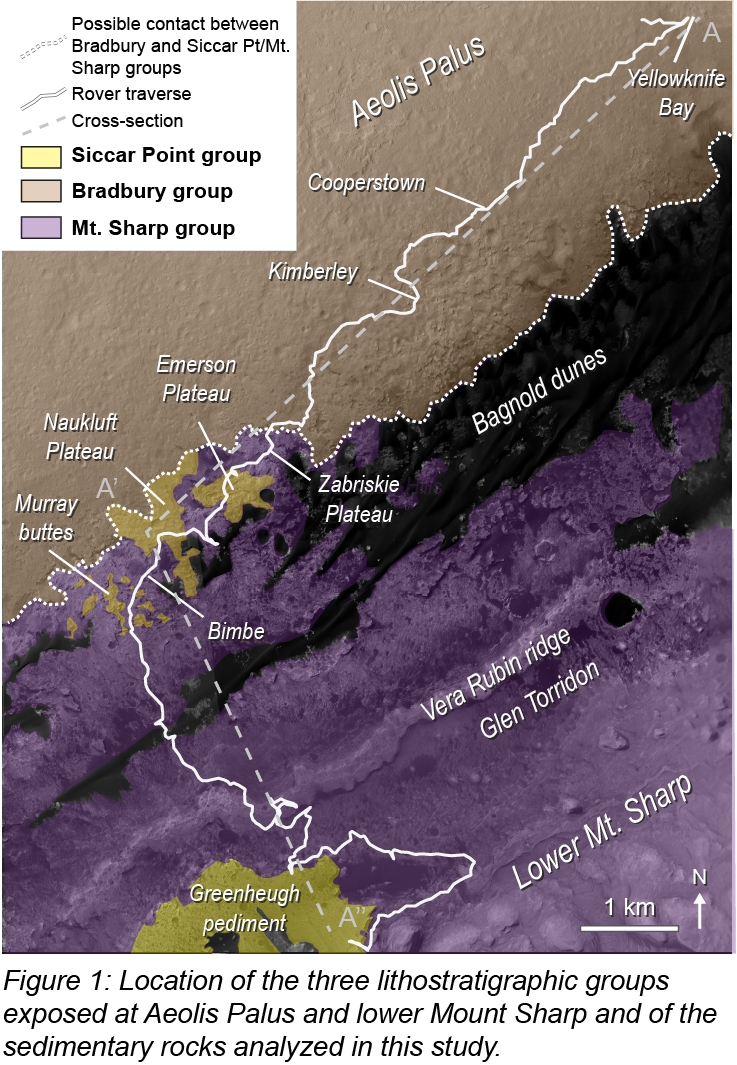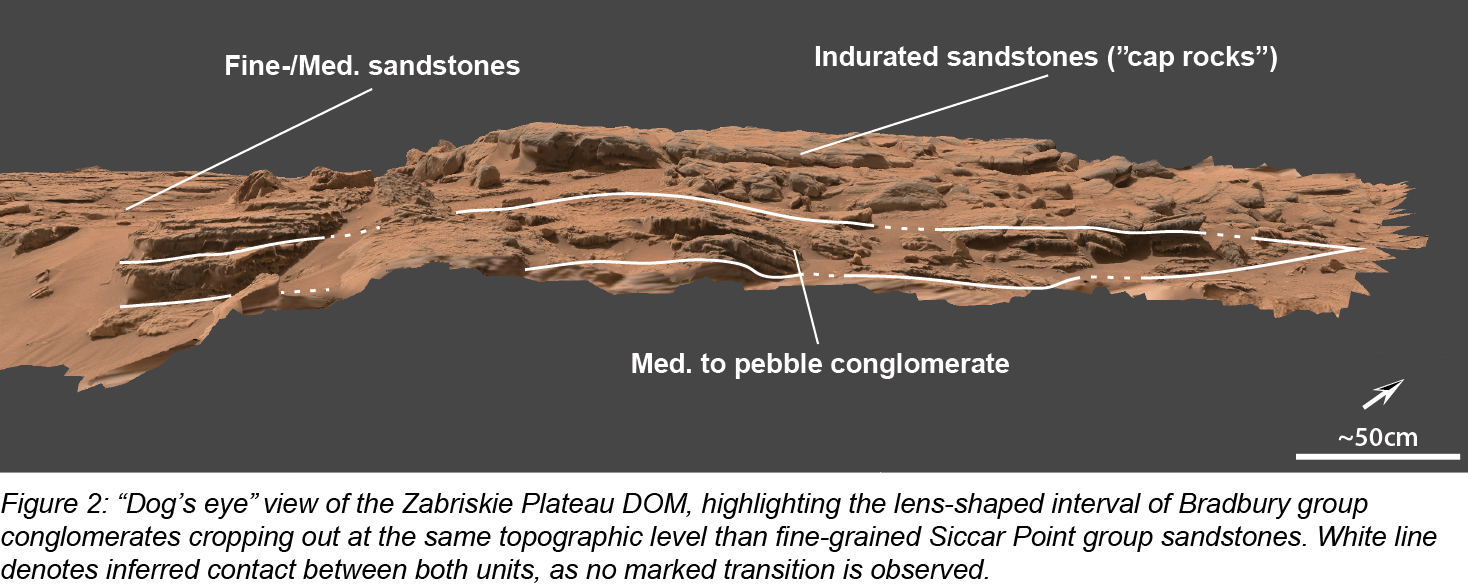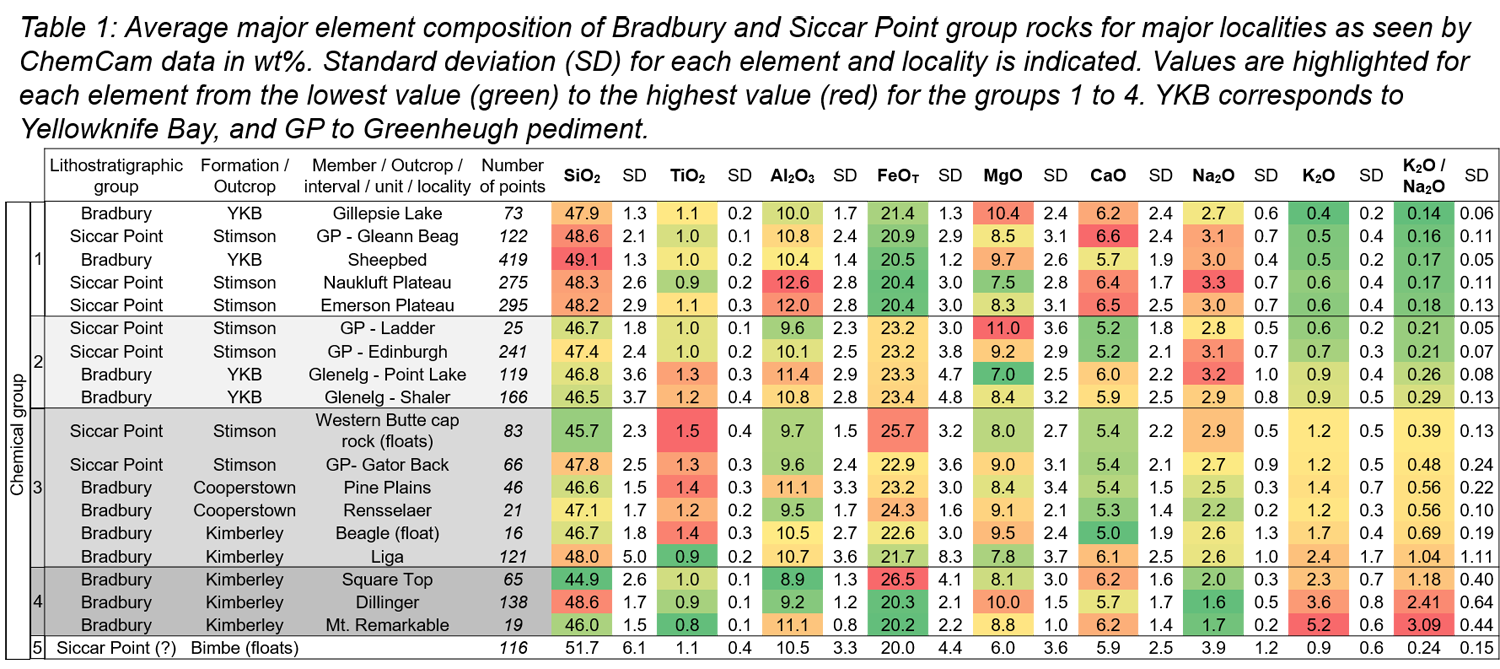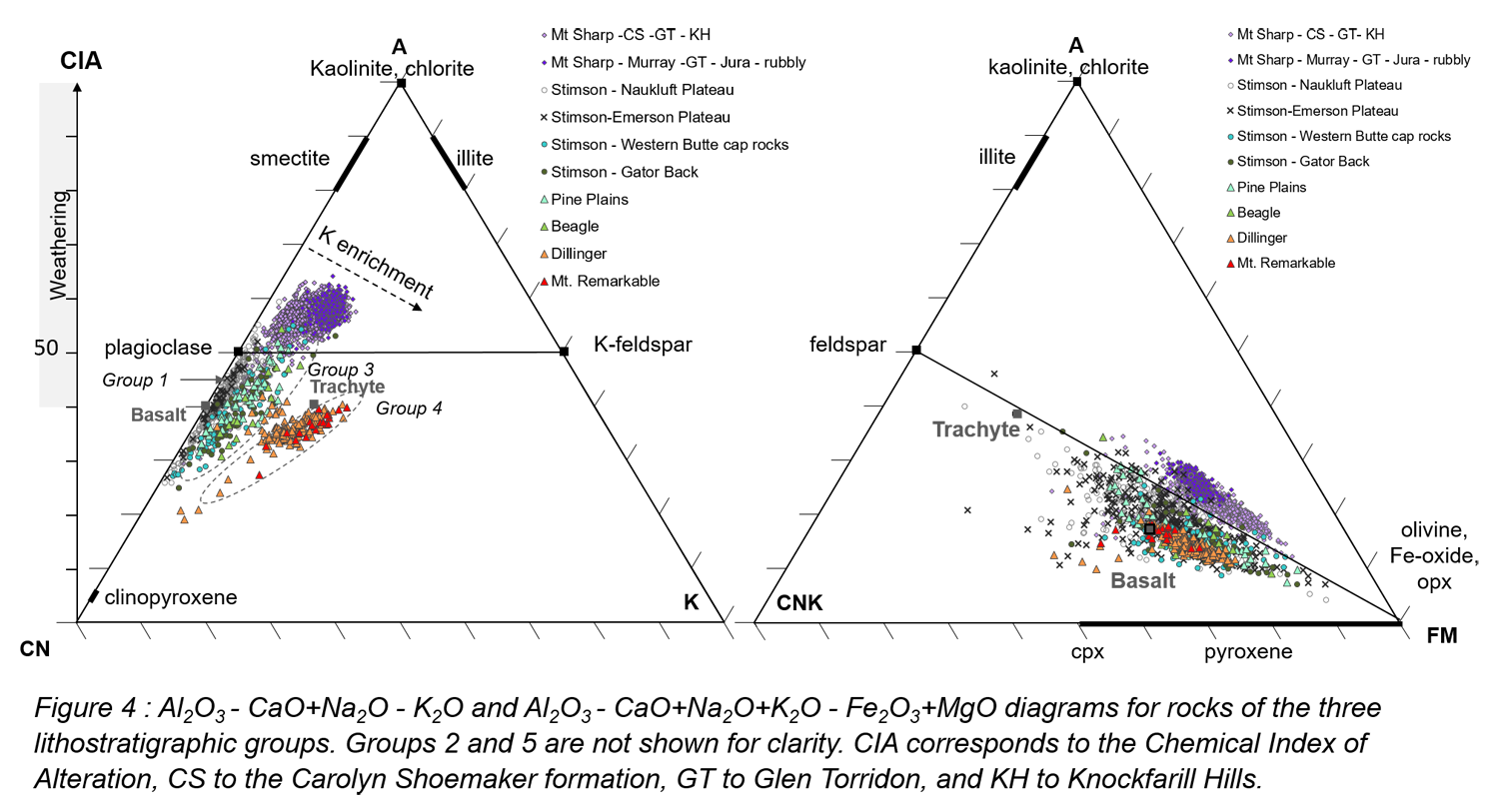- 1Laboratoire de Planétologie et Géosciences (LPG), Nantes Université, CNRS UMR 6112, France (laetitia.ledeit@univ-nantes.fr)
- 2Institut de Recherche en Astrophysique et Planétologie, Université de Toulouse, CNRS, CNES, France
- 3Univ Lyon, UCBL, ENSL, UJM, CNRS, LGL-TPE, F-69622, Villeurbanne, France
- 4Lunar and Planetary Institute, USRA, Houston, TX, USA and NASA Johnson Space Center, Houston TX, USA
- 5Purdue University, USA
- 6LANL, Los Alamos, USA
- 7Johns Hopkins University Applied Physics Laboratory, Laurel, MD 20723-6005, USA
Over the past 10 years, the Mars Science Laboratory (MSL) rover Curiosity has been investigating the plains of Aeolis Palus and the lower reaches of Aeolis Mons (informally known as Mount Sharp), a 5 km tall mound of sedimentary rocks in Gale crater (Figure 1). After traversing 27 km and nearly 600 m of vertical stratigraphy, three lithostratigraphic groups have been identified: Bradbury, Mount Sharp, and Siccar Point (SP). The Bradbury group consists of fluvial, deltaic, and lacustrine sedimentary rocks [1-2]. The Mt. Sharp group mainly consists of laminated mudstones with minor fluvial sandstones, interpreted as evidence of a long-lived lacustrine environment [1]. Locally, exposures of the Mt. Sharp group are unconformably overlain by aeolian cross-bedded sandstones of the SP group, interpreted to have deposited on an aeolian deflation surface [3].

While these three groups show evidence of deposition in specific environmental and climatic conditions, knowledge of their stratigraphic relationships is a key information to understand the evolution of environmental conditions in Gale. Yet, no clear stratigraphic contact has been observed at the boundary between the Bradbury and the Mt. Sharp groups. Because the mean dip of the Bradbury group is approximately horizontal, the MSL team suggested that the Bradbury group might be stratigraphically lower than the Mt. Sharp group, and therefore lower than the SP group [1]. Nonetheless, orbital analyses of the region suggested that capping strata of the Bradbury group could be part of the SP group [4]. Chemical data from the ChemCam and APXS instrument suites of Bradbury and SP group rocks have recently shown that both groups have similar compositions and possibly similar sediment sources [5-8]. In this study, we aim to reappraise the stratigraphic and chemical relationships between the Bradbury and SP groups using Mastcam [9-10] and ChemCam data [11-12] to characterize the evolution of Gale’s ancient environment.

Lithostratigraphy of Zabriskie Plateau
One of the best candidates to assess the potential contact between Bradbury and SP group rocks is located at the Zabriskie Plateau outcrop in the Pahrump Hills area (Figure 1). To better appreciate the facies and 3D geometry of the contacts, this outcrop has been reconstructed as a Digital Outcrop Model (Figure 2, https://skfb.ly/o9ZAq) [13]. In this model, we observe that most of the outcrop is composed of fine to medium-grained sandstones, arranged in dm- to meter-scale cross-stratifications, similar to some of the aeolian facies of the SP group [3]. These sandstones exist as “capping rocks” similar to previously described examples [4], suggesting that they are locally well-cemented on the topmost meter. Near the base of the DOM, we observe a meter-scale, ~30-cm thick, cross-stratified lens-shaped interval of coarser medium to pebble conglomerate. This level represents deposition under energetic aqueous conditions to transport clasts up to the pebble size, more likely to pertain to a fluvial channel. Interestingly, this conglomerate interval is at similar elevation (within one meter) to the surrounding sandstones, with no apparent unconformity, likely evidencing a conformable emplacement of this level within the finer sandstone succession. This would argue that the conglomerate level was deposited synchronously with the finer-grained sandstones during the same depositional event.
Chemical composition of Bradbury and Siccar Point groups
The average compositions of Bradbury and SP group rocks are overall quite similar (Table 1), and clearly distinct from Mount Sharp group rocks (Figures 3 and 4). By analyzing the rock compositions of Bradbury and SP groups, we sorted them into five major chemical groups, which are, in order of increasing average K2O/Na2O ratio and average K2O content for groups 1 to 4: group 1 has a basaltic composition; group 2 has low SiO2, intermediate TiO2, high FeOT and Na2O contents; group 3 has low CaO, high TiO2, FeOT, and K2O contents; group 4 has low TiO2 and Al2O3, and very high K2O contents; and group 5 has a composition close to group 1 with higher SiO2 and alkali contents (Table 1, Figure 3). Overall, the MgO and Al2O3 contents are quite variable. The composition of these rocks suggests mixing between mafic minerals and feldspars, including alkali feldspars in various proportions (Figure 4). Interestingly, both Bradbury and SP rocks occur in the first three chemical groups, which suggests similar source rocks for both groups of at least two types: a relatively low-potassium basaltic rock and a potassic-rich rock. The relative abundance of potassic-rich source rock in the mixture is interpreted to increase from group 1 to group 4. Besides, Bradbury and SP group rocks have a low Chemical Index of Alteration (CIA), which is indicative of limited chemical weathering (Figure 4).




Conclusion
3D observations in the Pahrump Hills area suggest that Bradbury and Siccar Point units are intermingled and synchronous in an environment allowing fluvial episodes to occasionally occur among a drier setting, as observed on Earth [14]. This is consistent with the chemical compositions of Bradbury and Siccar Point groups which suggest similar source rocks in different relative abundances. This relationship implies that the Bradbury group could be younger than Mount Sharp group (Figure 5). To summarize, these observations are in favor of a common origin for both Bradbury and Siccar Point as a single clastic group, representing a temporal evolution from clement conditions during the deposition of Mount Sharp group to a colder and drier environment with still transient episodes of fluvial activity during the deposition of Bradbury and Siccar Point groups.
[1] Grotzinger et al., Science 2015. [2] Mangold et al., JGR 2016. [3] Banham et al., Sedimentology 2018. [4] Williams et al., Icarus 2018. [5] Bedford et al., Icarus 2020. [6] Bedford et al., JGR 2022. [7] Thompson et al., LPSC 2022. [8] Thompson et al., this conference. [9] Malin et al., LPSC 2010. [10] Bell et al., Earth and Space Science 2017. [11] Wiens et al., Space Sci Rev. 2012. [12] Maurice et al., Space Sci. Rev. 2012. [13] Caravaca et al., PSS 2020. [14] Newell, Marine and Petroleum Geology 2001.
How to cite: Le Deit, L., Caravaca, G., Mangold, N., Le Mouélic, S., Dehouck, E., Bedford, C. C., Wiens, R. C., Johnson, J. R., Gasnault, O., Forni, O., and Lanza, N.: Investigation of the stratigraphic and chemical relationships between Bradbury and Siccar Point lithostratigraphic groups in Gale crater, Mars, Europlanet Science Congress 2022, Granada, Spain, 18–23 Sep 2022, EPSC2022-508, https://doi.org/10.5194/epsc2022-508, 2022.

